




This truly school-wide collaborative efort, approached by faculty and staf in a way that mirrors how they approach children in the classroom, has energized, motivated, and refreshed educators around the country.
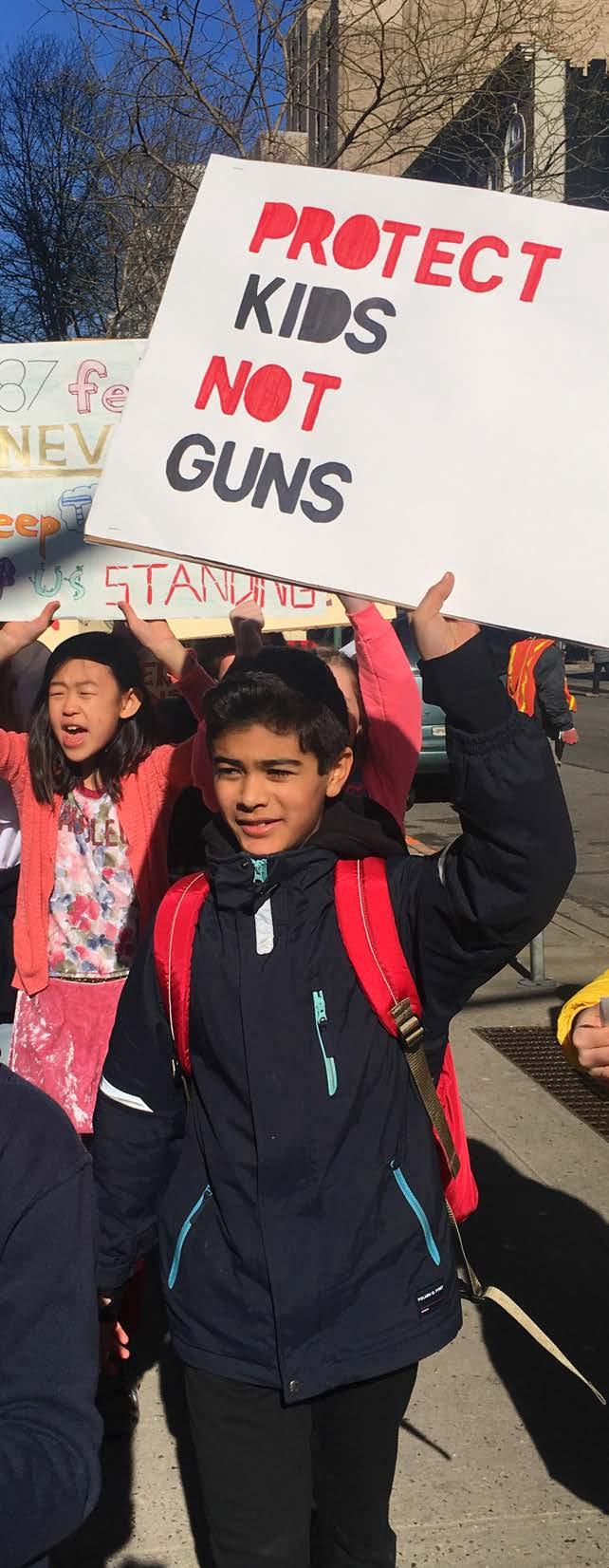
1 2 3
4 6 16
Letter from the Principal
XIII’s-Eye View of C&C
Summer Grants
Parents’ Corner
Sideless Slide
Around C&C
Alumni Updates
Your Support
Issue One
Spring 2018
Matthew D. Payne Editor and Director of Communications
Penny L. Arnold Director of Development
Kelly Washburn
Manager of Annual Giving and Special Events
Designer Gin Chen
Photography
Santiago Felipe, Matthew D. Payne, Elise Bauer, Gee Roldan, and Kay Boyes
Contributing Writers
Matthew D. Payne, Elise Bauer, Brian Kaplan, Dannielle Kyrillos, and C&C’s Class of 2018
Principal
Scott Moran
Director of Admissions
Elise Bauer
Director of Community Life, Equity, and Inclusion
Millie Cartagena
Director of Development
Penny L. Arnold
Director of Finance and Operations

Dorothy M. Lamonaca
Director of Lower School
Jane Clarke
Director of Middle/Upper School
Michele Bloom
City and Country School
146 West 13th Street
New York, NY 10011
212-242-7802
communications@cityandcountry.org
cityandcountry.org
CandCSchool
@cityandcountry
Dear C&C Community,
After being so warmly welcomed back to C&C, it is a pleasure for me to welcome you to Works in Progress, the new magazine of City and Country School.

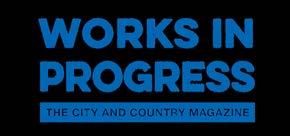
This magazine was in the works before I returned to C&C as Principal. Last year, Currents, our program-focused publication that has traditionally only been sent to current parents (thus, the name!), was for the frst time sent to alumni, alumni parents, and grandparents as well. The results were fantastic—everyone wanted to know more, questions were asked, and memories were shared. It was clear that everyone in our community would beneft from knowing more about our program. Similarly, our families would beneft from focusing in more sharply on the stories of our graduates.
So, this new magazine is an amalgamation of our previous Currents and Alumni Newsletter publications, but with an approach that we hope you will fnd refreshed and more engaging.
The title, Works in Progress, hints not only at the hard work taken on every day by our students, but our progressive roots, and the fact that our program, our community, and each of us within it is constantly evolving—as individuals and as a group.
This magazine signifes that, even with a 100+ year head-start, C&C is constantly progressing; re-thinking and re-working what it is we do and remembering why it is important. You can see this in our feature article on social justice in C&C’s program a component that has been in place at the School since its inception, but that we’re approaching in a refreshed way.
We hope that you enjoy our new magazine. Please reach out and let us know what you think.
Best, Scott Moran
Principal
Parents’ Corner is a space where current parents, in their own voices, talk about their experiences at City and Country School. In this inaugural edition, we’ve asked Dannielle Kyrillos (Caspian, VsW and Calliope, IIsS) to speak about some of the many ways parents volunteer at C&C.
“Mom, where’s my wolf shirt? I need to wear it.”
Apart from, oh, I don’t know, “I made this box for you in wood shop because you’re the best mom ever” or maybe, “You pack the greatest lunches in the world—defnitely better than Dad’s,” very few declarations from my son, Caspian, a V, make my heart swell bigger with pride. This is because I helped create that shirt, as one of three parents currently spearheading the School Shoppe.
The Shoppe is an arm of the Parents Association whose purpose is to outft our school community in a decidedly C&C favor of spirit wear, mugs, pouches, and more. In doing so, we raise funds for all the awesome work of the PA (community-building eforts such as Parents Meetings, events and guest speakers, and holiday gifts for faculty and staf). In recent history, the Shoppe has been run for a few years at a time by handfuls of parent volunteers charged with designing and sourcing the merchandise and holding a sale each month. We also set up Shoppe at the Harvest Festival and Spring Fair, as well as create the tees Elise Bauer uses to welcome new students each year. The sales themselves, held in the front lobby during morning drop-of, are the one day a month we get to take a break from the mad rush to say hello to, and reconnect with, every single person who walks in the door, so there’s a fun social component, too.

Allison McGowan (Leo, VIsT), Monica Arazi (Nico, VIsT and Leo, IVsL) and I “inherited” our Shoppe duties in 2014 from the former proprietors, including prolifc volunteer Sabrina Ellis (Ahilya, IXsK). We know that the Shoppe’s modern incarnation began as a PA initiative led by parent
One of the absolute coolest parts of working on the Shoppe is getting to sift through C&C’s collection of student artwork (with huge amounts of help from Archivist and parent Jordis Rosberg (Oona, VsW)). This is our main source of inspiration for shirts, hoodies, pants, and more. XIs Literary Journals going back nearly 100 years ofer a treasure trove of wood block prints that we convert into printable fles. There’s often poetry that the students wrote to accompany their carvings, and in choosing each piece we learn a little about the School and its community at that moment in time.
For instance, the “wolf” on the shirt my son loves so much is actually a dog, according to the pretty epic poem with which it appears; the print was created in 1935 by Sally Willcox ’37, who was one of a family of four kids who attended C&C in the 1930s. Sally returned to C&C as a Science Teacher along with her husband, Roger, some years later. Their two sons (Steve ’65 and Paul ’67) graduated from the School. Of course we didn’t know any of this when making the shirt—we just loved the image. That a V in 2018 is obsessed with a picture created by an XI in 1935, and that my work not only helps that V show his school spirit in this way but also gives a long-ago student’s work a whole new life, feels about as C&C as it gets. I’m humbled and honored to get to play a tiny part in connecting our future to our past.
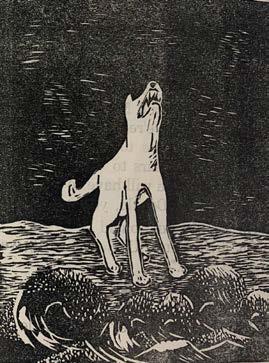 Donna Green (Ali ’02 and Max ’07) sometime in the 1990s.
Donna Green (Ali ’02 and Max ’07) sometime in the 1990s.
The next time your partner is obsessing over their recipe for the Chili Cook-of, or your kids are begging you for more tickets, take a moment to consider the miracle of planning that happens in the months before any of our fun weekend ragers. Leading preparations for C&C’s two biggest community-wide events, the Harvest Festival and the Spring Fair, has traditionally fallen to the Parent Association’s Vice President(s). In 2016 that brave soul was Crystal Wald (West, VsA and Jaxton, IVsN), who organized the Fest and Fair singlehandedly that year.
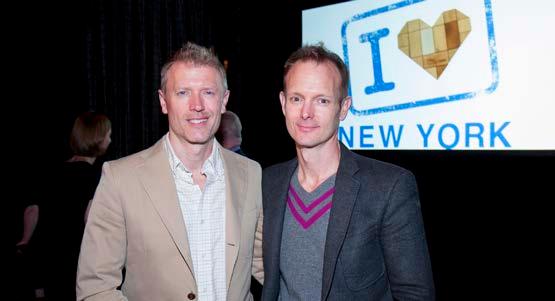
Elegant, warm, nuanced, thoughtful, and welcoming: You could describe the feeling that enveloped you walking into the party celebrating former Principal Kate Turley’s retirement with words you’d also use to describe Kate herself. That’s no coincidence, as the rooms were expertly designed to embody Kate by Joe Williamson and Dale Saylor (Henry, IVsN). In addition to being C&C parents, they have day jobs running a design and production frm.
The pair dove into C&C event design during Henry’s frst year at school in 2015, when they crafted the look and feel of the Harvest Festival and the XIIIs lounge at the Spring Fair. Last year their genius eyes gave us all that magical night to salute our beloved Kate as well as the Beneft, and they were at it again with this year’s Beneft. Joe says, “We do what we do because that’s our area of expertise, and that’s the best you can do, right? Go with your strengths. We also just love doing it.”
A planning powerhouse who prefers to work hard under the radar, Crystal could not be reached for comment, but one of two co-VPs who jumped in to lend a hand this school year, Deborah Brown (Maya, VsA and Benji, IIsS), has this to say about these Herculean eforts: “It was really fun! I learned so much more about the School, the people, and the behind-the-scenes of what really goes into a production like this (event planning is completely outside my wheelhouse!). It’s a lot! But doing it with Crystal makes it easy, because she’s so good at it, and you know it’s going to be a success.”
Deborah, who along with co-VP Tracy White (Suniva, IXsJ, Kiran, VsW, and Bronya, IIsS) supported Crystal in throwing Harvest Fest 2017 adds, “I also thought it was nice to model for my kids a sense of responsibility for one’s community. So, like my V has a job in the Classroom, part of the job I do at the school is help plan the festivals and give back to the community in a tangible way.”
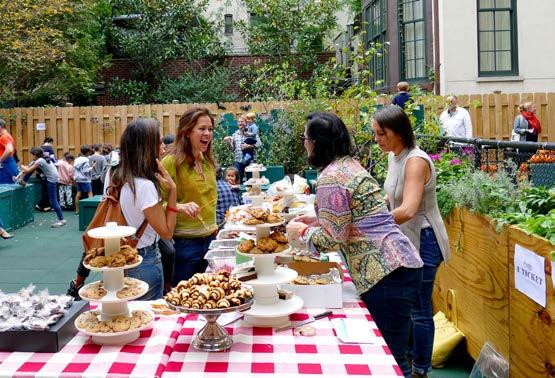
If you think about it, Deborah, Crystal, and Tracy aren’t just planning these parties for our community, they’re planning memories that our kids will carry with them forever. Says Deborah, “I’m super excited for the Spring Fair because we get to work with the XIIIs to make a special event for them. We already have an awesome theme.…” We can be certain it will be incredible.
To Joe and Dale, volunteering is just a natural extension of being part of a community like ours. “One of the frst things that attracted us to C&C was the sense of community; that parents were really involved in the school,” explains Joe. “It isn’t just a place where you drop your kids of and then pick them up again fve days a week. Really, when a kid goes to C&C, the whole family goes. Seeing how much other parents give to the school really inspired us to get involved.”
And of course, they think about the impact their involvement at school has on their son. “As for what we want Henry to take away from this, we want to teach him the importance of giving back and contributing to your community; that you take care of what matters to you. And as we all know, kids learn so much by what we show them—how we live our lives teaches them how to live theirs.” In terms of whether Henry will carry on the family volunteer trade, the jury’s still out. “I’d also like to think our design sensibility is rubbing of on him, but I’m not holding my breath,” Joe opines. “He’s waaaaayyyy more interested in fre trucks than color schemes!”
For more information on all the ways parents can volunteer at C&C, parents can log into the Online Community and reference the PA Resource Board.
Showing people around City and Country never gets old. As Director of Admissions for the past nine years, I have given more tours of the School than I can count, and it continues to be one of my favorite aspects of the job. For me, a highlight of touring people is the moment when, after going through the passageway toward the 12th Street Building, the space opens wide to reveal an open sky and the entire campus of our seven brownstones, multiple play yards, the unique outdoor blocks, and of course, our climber, complete with monkey bars and a slide with no sides.
People don’t expect the School to be so expansive. I watch their faces in this moment and note their pleasant surprise as they take it in.
With each tour group I then focus on our outdoor blocks as we watch children at work and discuss the signifcance of these materials. Most people have not seen anything like our green blocks. Nor have they seen anything like our slide. As we move closer to it, I pause and pose a question to the tour group. “Take a look at our slide for a minute. Why do you suppose we’d have a slide like this?”
Back in 2000, when I served as the Director of the Lower School, Lower School teachers and I decided that we wanted to build some sort of playground apparatus that would complement the outdoor blocks. A search of the C&C Archives uncovered many photos of a climbing
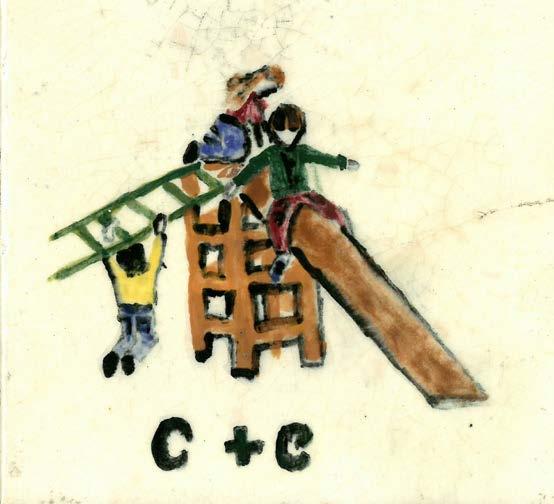
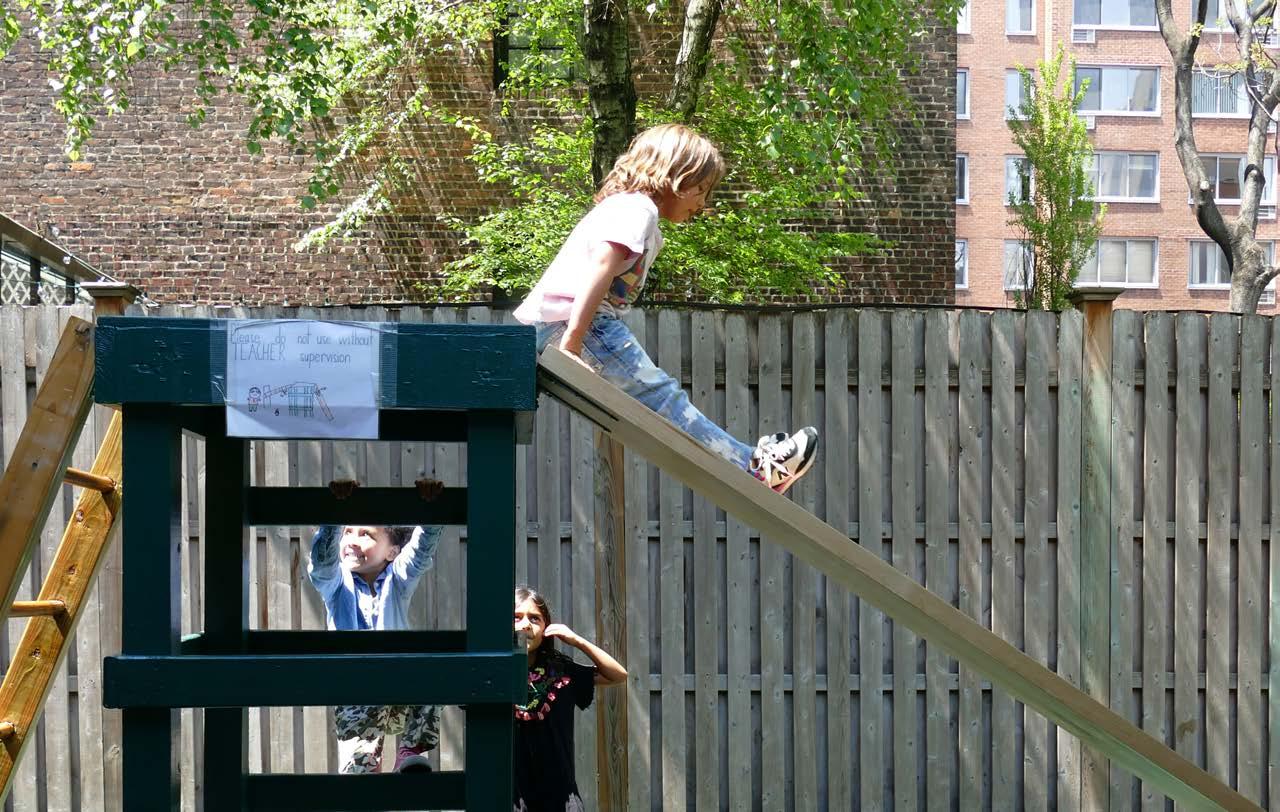
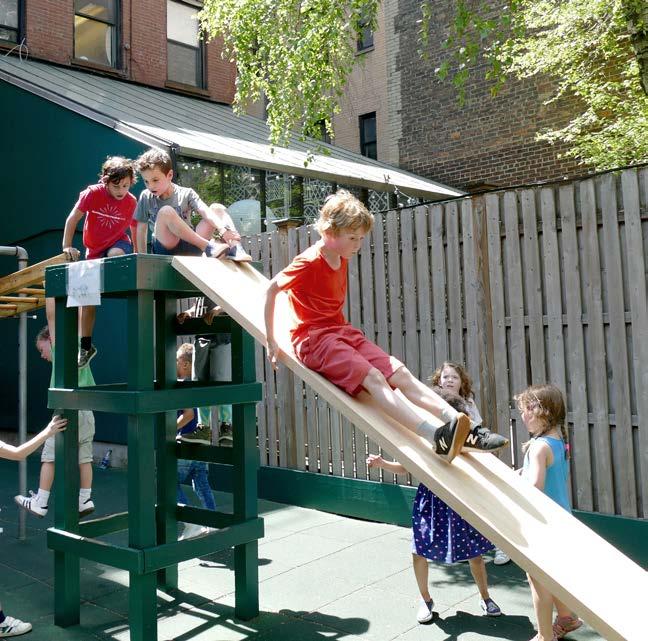
structure from decades ago. What may look to some to be a crude assemblage of a ladder, beams, and a slab of butcher block, the climber in the pictures was a masterfully simple structure that exemplifes much of what C&C is about. We chose to rebuild this archival climber and slide on the same ground 50 years later because we knew that it would ft the bill perfectly.
C&C is about do-it-yourself innovations and natural materials. The climber? It’s designed by C&C teachers, is made of wood, metal, a cement foundation, and a few coats of green paint—and all put together by our crew of carpenters and facilities people.
Archival Tile Painted by C&C Student, Date Unknown.Simple by design is one of C&C’s hallmarks. Much as our classrooms have a clean, spare aesthetic, free from commercially made items that tend to dampen attention spans and overly stimulate or “entertain” the children, the climber could not be more basic. Just like with our indoor basic materials of blocks, paint, and clay, there are no wheels, bells, or colorful fags that tell the children how to play. Instead, there are adjustable monkey bars that challenge children on multiple levels. There is a high platform. And there’s the slide, a substantial, sanded piece of oak, whose deep patina proudly advertises the countless fights of the children over the years.
C&C values reasonable risk-taking. One glance at the climbing platform, and you’ll see that it’s pretty high and has no railings. You’ll also see our sideless slide. Unlike with commercial jungle gyms with handrails, and molded sliding boards that have a deep chute, children must be mindful when using our equipment. Our structure requires them to exercise their physical strength, body awareness, balance, and impulse control. They hone these important skills each time they play outdoors, and for C&C kids, that’s every day.


At C&C, children are trusted to use their natural instincts for safety. We believe that safe behavior is learned by repeatedly navigating situations that present a reasonable amount of risk. Think of our IVs at the woodworking bench with real hammers and saws, Lower Schoolers outside

lifting heavy boxes and climbing their block structures, VIIIs burning logs like the Lenape did, IXs whittling with real knives like the pioneers, and XIs operating serious pieces of machinery: the printing presses. Each of these fully engaging experiences ofers children the opportunity to recognize boundaries, learn patience and caution, master valuable practical skills, and in the process, develop their resourcefulness and confdence.
I always give my tour group a moment to ponder my question about why we’d have a slide like ours. To many people, it’s not obvious. As they look at the unusual structure before them, some people take guesses. “Because it’s made of wood like the blocks?” or “Because it’s homemade instead of commercially produced?”
Others get it right away. “So that children can learn to be careful,” and “So kids can learn to control their bodies” are common responses. I remember one person saying, “So children can build their courage.” I especially liked that one as it taps into the fearlessness that I often see in our graduates.
There are many “correct” answers to the question, but I’m certain of one thing. Our slide with no sides is an embodiment of how I often think of City and Country School: simple and humble at frst glance, but complex, sophisticated, and challenging upon closer inspection.
“Take a look at our slide for a minute. Why do you suppose we’d have a slide like this?”
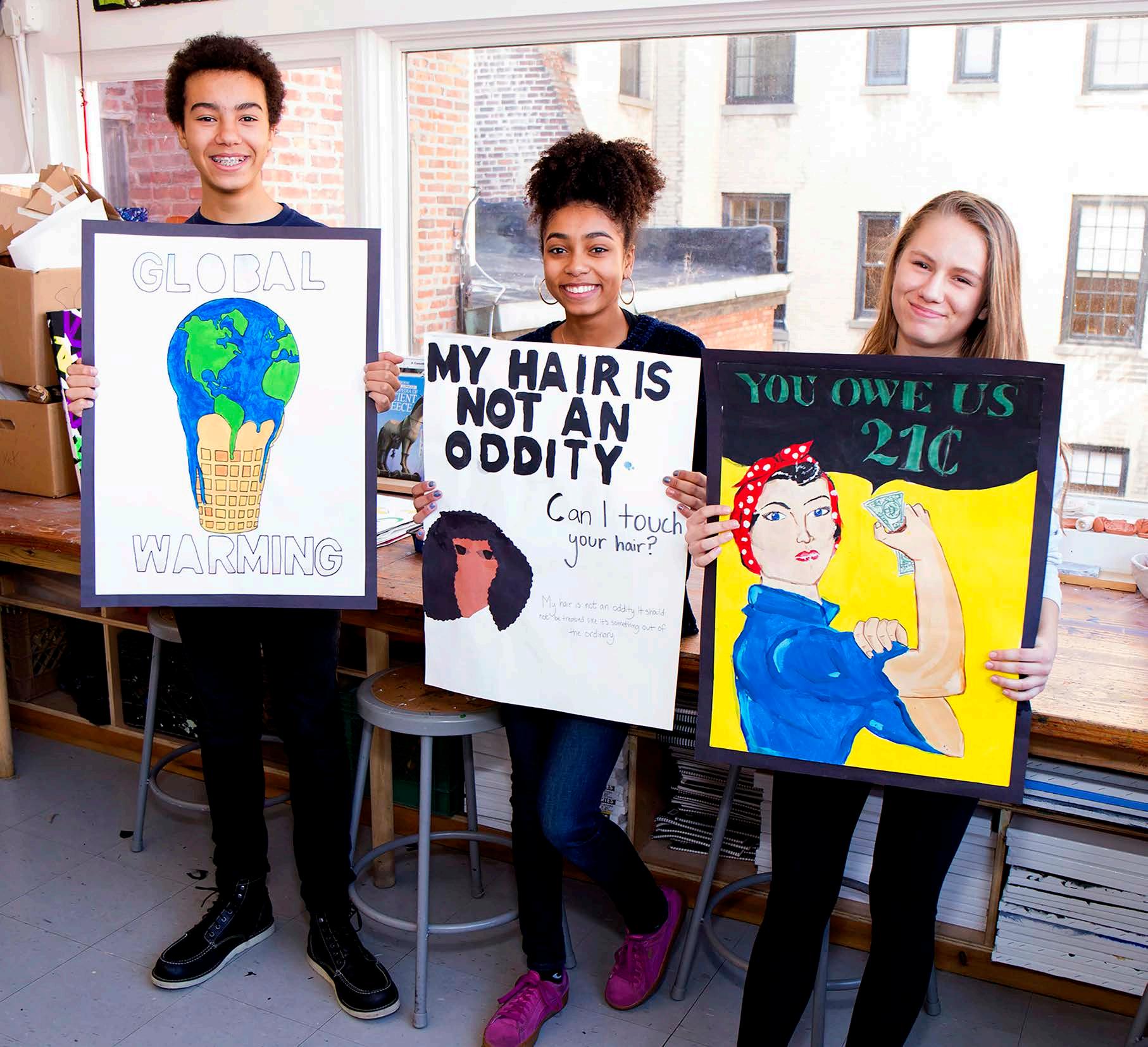
There was a standing-room only crowd at the 2017 National Association of Independent Schools (NAIS) People of Color Conference (PoCC) as C&C staf members gave a muchanticipated presentation on “Schoolwide Social Justice Integration Across Ages 2–13: Lessons From a Work in Progress...”
Director of Community Life, Equity, and Inclusion Millie Cartagena, Director for Specials Program and Integration Gee Roldan, and Middle and Upper School Social Studies Consultant Joan Brodsky Schur described C&C’s collaborative process and school-wide approach when identifying and developing ageappropriate dialogue around social justice concepts.
The presentation was followed by an interactive workshop, and, by the end, attendees looked forward to using the resources and implementing a similar process at their own schools.
Before going national, the team presented the School’s approach twice to New York State educators, and several times to various C&C constituencies, all within the space of a year. At last October’s Parents Meeting, parents were eager to engage with information about children’s evolving awareness of diference.
Parents Association Co-President Nick Smart says about the presentation: “To learn how City and Country communicates the language of diference and promotes the values of social justice— to experience the sophistication and sensitivity of the approach— was heartening.”
Shortly after they returned from the PoCC, they shared the presentation with alumni at a special event in December: “In Search of Justice: Through the Years at City and Country” (see page 15). They’ve also shared their work with the Board of Trustees.
Board Member and Diversity Chair Veronica Savage says, “I believe the social justice integration framework is one of C&C’s most powerful tools for advancing diversity, equity, and inclusion at our school. It is designed with the premise that all students beneft from meaningful conversations about who we are, the world we live in, and how to make it safer and more equitable for all of us.”
Millie, Gee, and Joan will be the frst to tell you that this work is not about them—it’s about C&C’s educators.
“I’m always honored to share the work that our faculty is doing,” says Millie.
Joan says, “This work is all about collaboration and helping to move things forward. City and Country, its ethos, and the educators it attracts and nurtures, this is what makes this work possible and of value to educators at other institutions. If it weren’t for the quality of the staf here, it just wouldn’t be possible.”
This truly school-wide collaborative efort, approached by faculty and staf in a way that mirrors how they approach children in the classroom, has energized and motivated educators around the country.

2015–2020, social justice was a “hot topic” staf took up for further discussion. A working group in the Middle and Upper School was formed to determine how to move forward.
Diversity, equity, inclusion, and social justice all play an integral role in C&C’s underlying philosophy. As a progressive school, we believe that a child’s learning should be rooted in their lived experience. As our founder Caroline Pratt stated:
It seemed to me that a school’s greatest value must be to turn out human beings who could think efectively and work constructively, who could in time make a better world than this for living in.
If we are basing our education of children in their lived experience and in the real world that has already socialized them, at times in negative ways, then we must be thoughtful about what we study—and from what perspectives. Whose stories is C&C telling to our children? Through whose eyes are students looking? What is C&C, as a community, talking about? What is it, perhaps, C&C is struggling to talk about? How does the structure of our classrooms afect this work?
C&C strives to develop empathy in our students—not just an appreciation of diferent perspectives, but an understanding that without various perspectives, you can’t know the whole of something. Seeing only your perspective or the perspectives of people like yourself leads to a biased and inaccurate version of reality. But is C&C truly fulflling that objective?
In 2014, after the New York State Association of Independent Schools (NYSAIS) 10-year accreditation, as well as work done in setting up our Strategic Plan
The working group attracted over 15 individuals (most working groups have four to fve). It was clear that C&C staf found social justice relevant. This, coupled with the social and political climate and evolving views of selfidentity, made this work even more urgent. It became clear that any exploration needed to include the Lower School and administrators. Millie, Joan, and Gee were asked by Kate Turley, Principal at the time, to implement a schoolwide initiative to further conversations and foster an exploration of how C&C integrates social justice concepts within the existing curriculum.
As Director of Community Life, Equity, and Inclusion, Millie encourages teachers to foster conversations about diversity, equity, and social justice issues. She brought the experience of 20-plus years of work she’d already done in both Divisions at C&C.

Gee is a former IXs and Xs Group Teacher who was Associate Director of Middle and Upper School before taking on her current role as the Director for Specials Program and Integration.
Joan is a former XIIIs Group Teacher (1971–1978) and is currently Social Studies Consultant for the Middle and Upper School.
Millie’s, Gee’s, and Joan’s professional experiences and cultural experiences (Millie identifes as Afro-Latina, Gee as Asian American, and Joan as White; all three identify as cisgender) complemented one another and also allowed for each of them to reach out to diferent constituencies throughout the school. And through the process, they’ve formed a bond that is easily seen when they talk about each other.
EMPATHY [em-puh-thee] noun
The ability to understand and share another person’s experiences and emotions.
“Millie was not a person I knew very well in school until we did this work,” says Joan, “and it was her knowledge, her warmth, her openness and commitment that made me feel well-led in this experience. Gee was already ahead of me also on thinking about a lot of these issues and she brought such a teacher’s way of framing and thinking and working methodologically with this wide group of staf members.”
“Joan brings language,” says Gee, “and she’s always thinking of the foundations of this institution, which I think is very valuable. She keeps the focus on the School’s mission and history.”
Of Millie, Gee says, “Millie can talk about the history, the shifts, the changes in how this work has been approached at C&C.”
“Gee has always been involved in diversity and social justice work at C&C,” says Millie. “I quickly realized that Joan was an ally and that as a white colleague she was open to self-refection when talking about race and racism. That allowed for real conversations around issues that could have been very difcult to have.”
“All three of our personalities and leadership styles are very diferent,” says Gee. “We all have a diferent way of navigating that. It’s been fascinating. I think all three of us have grown incredibly throughout the last four years.”

A trusting relationship developed between Millie, Gee, and Joan, which enabled them to be fully present and engaged when working together.
Millie, Gee, and Joan used the initial conversations that had bubbled up in the Middle and Upper School working group as the map for the road ahead. As Gee explains, “Faculty and staf were curious to know at what age

DISCRIMINATION [dih-skrim-uh-ney-shuhn] noun
The practice of treating one person or group diferently from another in an unfair way. The action by an institution or individual that denies access or opportunity to people based on their social identity (such as gender or racial identity). Outcomes of such actions, rather than their intent, are the basis for use of the term.
children develop an understanding of racial identity, culture, and attitudes. And, as an adult, if I have a hard time defning a lot of these concepts, how do I explain them to a six-year-old or to an eleven-year-old?”
There was a clear need to create a chart, based on research and refned with the staf, that outlined at what point in their development children recognize and begin to understand social justice concepts.
In addition, for several years, Millie and Kate had discussed a need for a common language around social justice concepts. A glossary of terms would be necessary for conversations between staf members and between teachers and students.
As Millie says, “It all boils down to a need to equip staf with a common language to speak with each other and their children about these concepts.”
Clearly there was ample work at hand. But, aside from taking the two ideas of creating a social justice glossary and developmental stages chart to the whole school, Millie, Gee, and Joan approached the staf in a way that was similar to the way that our teachers work with students—everything would be worked through as a community. They were focused on shaping the dialogue,
“This really is a combination of the work that we’re doing together as a faculty and also the individual responsibility we have as teachers to actually bring it to life.”
guiding the whole school along in the process, and listening in the same way that our teachers listen to and guide their students.
“This really is a combination of the work that we’re doing together as a faculty and also the individual responsibility we have as teachers to actually bring it to life,” says Robin Sage, IIIsR Group Teacher.

And, just like our students’ natural curiosity is fueled by our program, so too did this issue get raised at a time when it was clear that faculty and staf were ready to tackle it.
“People wanted to know more,” says Gee. “The Lower School wanted to know which social justice topics are brought up by twelve-year-olds. Xs Teachers wanted to know if three-year-olds talk about skin color. There was a natural curiosity, so the timing was really right for all of those reasons for us to do it.”
Despite the overall feeling from the entire staf that there was a clear need to do the work, it has at times been challenging. Of course, there were moments of struggle and questioning.
“This process is work,” says Robin. “This isn’t Millie, Gee, and Joan giving us a handbook and saying, ‘this is how it is.’ Every Group will be diferent and every year will be diferent. And we’re going to be learning in real-time with our children, and of course we’ll have questions and make mistakes.”
“I never went into an All Staf Meeting thinking that we weren’t prepared,” says Millie, “but I did go in thinking, ‘What will the feedback be? And how will that inform the next step?’ I always ended meetings by thanking staf and faculty for challenging themselves by engaging in these sometimes difcult conversations. Conversations around race and racism can be uncomfortable. The discomfort can come from a fear of misspeaking, sounding racist, unintentionally doing harm, or feeling vulnerable. This is why we always start our meetings by reviewing our Community Norms Contract, which hopefully helps folks to fnd courage to engage.”
experiences around race and racial inequality,” Millie says. “But, the more practice one has, the more manageable the discomfort becomes. Conversations might not get easier but the ability to press forward and stay engaged does.”
Overall, the staf was excited to move forward, and a true feeling of progress kept everyone motivated. Their ability to crystalize thoughts around actionable points that everyone could feel comfortable with was key.
“One of the great strengths of this staf,” says Joan, “is that they are so thoughtful and articulate. Over the course of the frst year-and-a-half, the discussions kept growing and moving, and everyone felt satisfed that their eforts were taking shape.”
Kate gave Millie, Gee, and Joan ample time for people to meet, work on documentation post-meeting, update information, and set goals. “I can only speak for myself being here 12 years,” Gee says, “but it was one of, if not the only, school-wide formalized ongoing record-keeping process for all faculty. I haven’t experienced anything like that in this setting.”
But as hard as some conversations were, the community was committed to pushing forward. “It’s common— normal, even—to feel discomfort when engaging in conversations that involve examining your own
Similarly, ample time was dedicated to refection. “Refection in general is vital with this work,” says Millie. “Self-refection doubly so when engaging in racebased conversations. It allows for an examination and interpretation of the experience, and it also helps build self-awareness—you gain a better understanding of your discomfort level, and your biases.”
“Dr. Stevenson recommends that, to become racially literate, individuals must foster the ability to ‘read, recast, and resolve a racially stressful encounter.’”
• Be respectful—be honest
• Create a liberated zone (safe, not necessarily comfortable)
• Engage our “growing edge”
• Respect confdentiality
• Ask questions in the room
• Struggle together
• No hierarchy
• Be present—stay the whole time
• No quick fx
• Call people in with afection—not out
• Ask for a literacy moment
Millie, Gee, and Joan also brought in experts, as requested by the staf, to provide more opportunities for C&C to be pushed and challenged, and through that, grow.
As Gee points out, this is the same type of thing that happens in classrooms with feld trips and speakers. “It’s one thing to pretend you’re an archaeologist looking at Ancient Egyptian artifacts, and it’s another thing to bring in a real live human being to share their lifework, study, and experiences on a very human level.”
In 2015, the People’s Institute for Survival and Beyond came to C&C to present a two-and-a-half day weekend workshop called Undoing Racism. The entire faculty and staf spoke about how racism has been consciously and systematically constructed—and how it can be undone through efective anti-racist organizing, with accountability to the communities most impacted by racism.
Millie, in listening closely to the community, and also following the change in how the newest generation perceived identity, invited the Ackerman Institute for the Family to the 2017–2018 opening All Staf Meeting. A full day was focused on creating gender-inclusive schools and supporting LGBTQ families beyond the binary. Staf spent time learning about the continuums of sexual diferentiation and gender fuidity, the diference between gender identity and gender expression, and much more. All of this training was done to assure that everyone’s identity will be refected in our everyday actions and language at C&C.

Most recently, on our Professional Development Day in February 2018, C&C invited Dr. Howard Stevenson to work with us.
A noted clinical and consulting psychologist and educator, Dr. Stevenson is Executive Director of the Racial Empowerment Collaborative, a research, program development, and training center that brings together community leaders, researchers, authority fgures, families, and youth to study and promote racial literacy and health in schools and neighborhoods.
Dr. Stevenson recommends that, to become racially literate, individuals must foster the ability to “read, recast, and resolve a racially stressful encounter.” In the morning he addressed the whole staf and faculty. Faculty spent the afternoon role-playing race-based conversations that they experienced and felt were handled well—and also ones that were not. He also met with Senior Administrators about nurturing a school culture that is inclusive to all. Millie, Gee, and Joan also consulted with him about how best to continue this work.
“We learned a lot from Dr. Stevenson,” Millie says. “What he brought, the tools that he gave us to use when faced with a race-based conversation, really resonated with faculty and staf—which again highlights how important it is that we engage with experts.”
There are a number of clear ways that the ongoing social justice integration has afected curriculum. Some are the larger pieces, such as the Social Justice Glossary and Developmental Chart, which are being used as a means to set age-appropriate goals within every classroom.
VIIIsJ Group Teacher Jay Frankel says, “It has been reassuring and encouraging to have those resources in place at City and Country School.”
“With those pieces in place, there’s a sense of accountability,” says Millie. “I’ve started to meet with the Lower School to go over the goals they set for themselves—personal goals in the classroom, wholeschool goals, what terminology from the glossary they have introduced. It is evident that they are doing the work. I had a conversation with a Lower School teacher who said, ‘I never thought I could use the word ‘empathy’ with the age group I teach, but I did, and it was successful!’”
“One teacher and I,” says Joan, “were just thinking about how the content in the second half of their year really lent itself in multiple ways to learning about social justice back in another era and today. Conversations like this really show the commitment teachers are making because it’s now at the top of the agenda for our community.”
Recently, IIIs Teachers Megan Lau and Robin gave a presentation on how this work comes to life in the classroom at the 2017 Progressive Educators Network Conference. Of the work she’s done with Robin, and former IIIs teacher William Harrison, Megan says, “IIIs have a strong sense of empathy and an interest in fairness, and they’re also seeking vocabulary for racial and ethnic identity. With these developmental stages in mind, we’re always mindful of the materials that we’re making available to the IIIs. For example, after a discussion of skin tone came up, we ofered some skin tone-colored collage material with which the children could be refective.”
Spanish Teacher Marianela Fernandez has since adjusted her curriculum to include more social justice topics, especially in the XIIIs, where she has added studies on water shortage in Bolivia and immigration in the United States. She is motivated because she fnds the work important on many levels. “The Spanish class is, by nature, a window to diverse cultures and experiences,” she says, “But our job cannot stop at simply showing children a diverse world—we also need to make sure their experience is present in the classroom. They should have mirrors to see themselves, so they can feel that they belong, and their uniqueness is refected in the learning experience.”
“The fact that our XIIIs can engage with social justice topics in very dynamic ways speaks to the entire experience they’ve had at C&C,” says Director of Communications Matt Payne. “Not only through
By 10, children have the cognitive ability to examine stereotypes and prejudices more objectively. Using new information, they have the capacity to compare and contrast diferent perspectives on an issue.
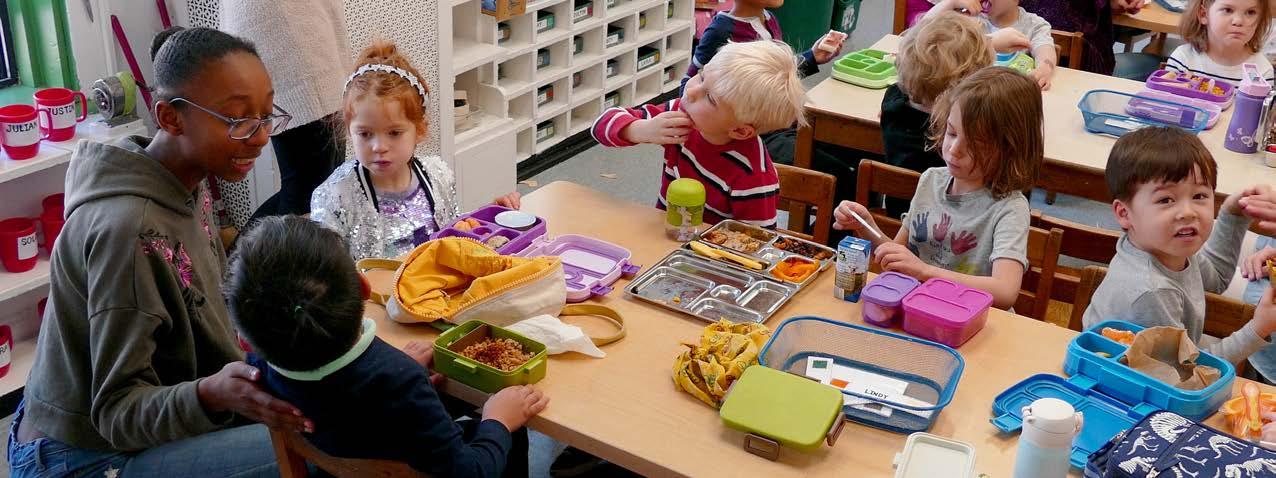
[IIs–IVs] are curious about physical characteristics of self and others (skin color, hair texture, gender anatomy). They may “match” people based on physical characteristics. Along with this, children this age can learn that skin serves the same purpose for everyone, regardless of skin color, and appreciate that all colors are beautiful.
the newspaper, which has shown a history of topics being tackled, but also through new initiatives that have come out of the social justice integration work, such as the new work in Spanish and creation of protest posters.”
“Many changes have happened outside of the classroom because of this work as well,” says Millie.
The Board has become more engaged with the work. Veronica says, “The Board has expanded its own social justice lens by engaging in racial equity training and applying that lens to our policies, practices, and school culture.”
“The fact that our XIIIs can engage with social justice topics in very dynamic ways speaks to the entire experience they’ve had at C&C.”
Afnity groups have been present at C&C as early as the ’90s, starting with the Students of Color group. More recently an LTBGQ+ student group and White Anti-Racist staf group—which works in accountability with the Staf of Color group—have been added.
Of the work the White Anti-Racist group is doing together, XsMe Group Teacher Megan Holland says, “As a white person, grappling with my whiteness—how it shows up in personal relationships, in our work with colleagues, in our classrooms, and as we move through the world—is not something that I am forced to do very often. I value the tough conversations that we have in the white afnity space, and as I feel challenged to be vulnerable and get real, I also feel very supported.”
Millie, Gee, and Joan’s frst presentation was for a NYSAIS Diversity Workshop that was so successful that they were asked that night to present later that year at another NYSAIS event. Despite the early interest at NYSAIS Conferences, they weren’t sure they’d have the same big showing on a national level when they were asked to present at the PoCC in California. But just as it had at NYSAIS, the work resonated.
“The room was packed—160 people!” says Millie. “The room included not just teachers and administrators, but specifcally professionals in the feld of diversity who were eager to hear from us and the work we are doing. People came up to us afterwards, they couldn’t get enough of it. It was amazing!”
“I think it really validates the process-driven way the School works,” says Joan. “And it’s exciting that something that happens at this school, in this way, can make an impact on schools around the country. The progressive philosophy works!”
“From a little idea,” says Gee, “from a little seed, it grew into something that happened from the bottom up—everyone was given the space and time to experiment.”
C&C’s new Principal, Scott Moran, came into his position with full-on support for the work. Scott says, “I’m wowed by what has been done since I left as the Director of Middle/Upper School in 2012—the kind of thoughtful and collaborative work that is uniquely City and Country. I look forward to supporting this process as it evolves in the coming years—and the positive impact it will continue to have on our program and community.”
“I think that teachers will continue to reevaluate and look more deeply into their curriculum,” says Gee. “There’s defnitely more open dialogue. People can have those conversations and they don’t feel the need to close the door or whisper when they use a certain term or question a certain thing. That’s been the most refreshing thing, and we’ll continue to grow in having those conversations.”
As Joan says, “It’s critical that we all do this right now in our society. We can’t turn back. There is always going to be ongoing work. I’m just so grateful that I have so much more to learn and have colleagues to collaborate with whom I admire so much.”
City and Country School will continue to engage in this work not just because it’s the right thing to do—though that’s part of it. C&C’s faculty and staf continue to be fully committed to this work because it’s essential for all children’s (and adults’) ability to understand the world—and for the creation of an ever more democratic society.
On December 11, 2017, C&C hosted an event for alumni that highlighted this social justice integration work. The event also gave alums a chance to meet new Principal, Scott Moran. The attendees ranged from the Class of 1944 to the Class of 2009.
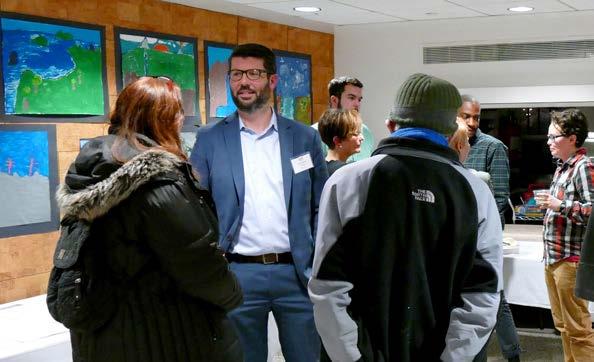
In addition to Scott, Millie, Gee, and Joan, Megan Lau, IIIsM Group Teacher, presented social justice work done with the IIIs. Director of Communications Matt Payne presented newspaper and journal artifacts culled by Archivist Jordis Rosberg and XIIIs Group Teacher Ann Roberts. Pieces ranged from an XIs Journal piece called “Hunted” by Marjory White ’28—told from the view point of an escaped slave—to the XIIIs’ Newspaper, 2001: A News Odyssey, which featured refections on diversity in every issue by Keshia Mora ’01
“But there was a forbidding thump, thump, thump. He knew that it meant men on horses, and men on horses meant losing his liberty.”
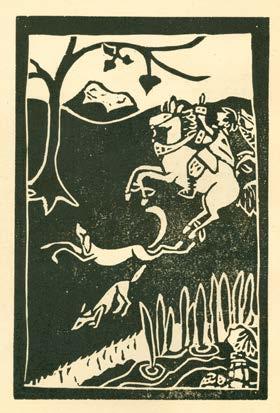 - Marjorie White ’28
- Marjorie White ’28
The Q&A section of the evening brought refections from our alums along with kudos that the School had spent such thoughtful time on social justice integration. It was also a wonderful way to converse with our new Principal. As Alan Herman ’58 stated, “It does seem C&C is in very good hands, indeed!”
In creating his National Book Award- and Pulitzer Prizewinning book, The Underground Railroad, author and C&C parent Colson Whitehead knew he wasn’t going to stick to the facts. He was, however, going to stick to the truth This was one of the many interesting bits of insight shared at a book discussion sponsored by the C&C Diversity Group.



Over the last few years, the Group has held a number of book discussions—many where the author was present, such as for The Fall of Rome (Martha Southgate) and The Tama River (Nobu Fukui)—giving a deeper insight into the complex issues of race and culture presented. Others had an interactive component—such as an evening of refection on poetry where attendees brought their own poetry. C&C Co-President and Professor of English Nick Smart (Penelope, VsA) has lead a few discussions, and alumna Emma Hale ’17 has returned for several book discussions that revolve around graphic novels.
Colson spoke of his infuences, people from Stan Lee and Stephen King to Ralph Ellison, Toni Morrison, and Thomas Pynchon. He also spoke about something he hadn’t dealt with before The Underground Railroad was published—
Each year, our Vs–VIIs can invite a special friend to visit their classroom. Here are a few photos of our most recent Special Friends’ Visiting Morning.

popularity. Despite the fact that Colson writes books with one audience in mind—him—this one resonated with a much larger group of readers than his fve previous novels.
Most insightful were his comments on how he created an alternate history that refected our current social climate— his answer to the question: Where is slavery still present today? Slave patrollers are today’s police. The three-ffths rule is voter intimidation. The list goes on and on.
“It’s important for our community to work through the issues of race and class that our country is currently dealing with,” said Millie Cartagena, Director of Community Life, Equity, and Inclusion, “Book discussions such as these are good ways to enter into that conversation.”
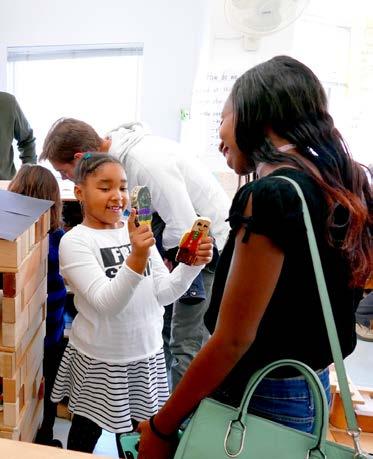
Colson also ofered up information that was pertinent to current parents, talking about how the main character, Cora, had a relationship with her mother that refects something that we can all relate to. “Parents are both the ‘heroes’ and the ‘biggest letdowns’ to their children,’” stated Colson.

Ann, one of the true mainstays of City and Country School, will be retiring at the end of this school year, after 33 years as a Group Teacher. She began at C&C in the fall of 1985 as a IVs Teacher and continued with the IVs for eight years. After that, she moved on to the Vs and developed that program into what it is today.
Ann has been active on the Education Committee, both chairing and serving as the Lower School representative multiple times. She was the faculty representative to the Board in 1999 during the search that yielded Kate Turley as our Principal, and when the School made the decision to purchase the brownstone at 150 West 13th Street. She also served on the search committee that brought Jane Clarke back to the School as our Director of Lower School. Ann even directed C&C’s summer camp for several summers.
Of her 30 years of experience, Ann says, “I have learned so much from children, teachers, and parents! What an amazing journey it has been. The thrill of teaching a Block

Program is hard to convey with words. There are many things I will miss about teaching. What I will eternally hold on to is my faith in our amazing materials and how universal they are. As well, the countless opportunities to work with so many devoted educators, from student to seasoned teachers.”

Ann will be sorely missed, though her contributions to C&C’s program will be felt for years to come. She looks forward to a wealth of activities and unscheduled time. “I am looking forward to reading in daylight hours, volunteering some time at soup kitchens, and spending time with friends and family who are long distance. Also just planning my days around my own calendar. A trip to New England to see the foliage, see more theater. I want to take an art, cooking, or history class.”
She is also excited to see how C&C’s program evolves next—and is committed to visit from time to time to check in. As she says, “C&C’s progress over decades will continue to inspire children, parents, and educators with Pratt’s vision.”


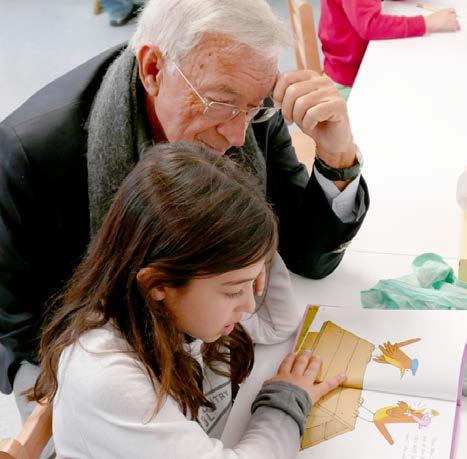
In November of 2017, Google Expeditions’ Augmented Reality Program came to C&C. This was a collaborative event organized by Al Doyle, Chair Web & Multimedia Design, Touro College; Ian Klapper, Technology Integrator/Support from C&C; AltSchool Head of School Alex Ragone; and Google.

Ian’s Computer students in the IXs and XIs, and a class of 5th, 6th, and 7th graders led by Melody Feo, Science teacher from the AltSchool, spent time using Google’s Augmented Reality app. Augmented Reality superimposes computer-generated information onto the image viewed through your smart device. Snapchat, Facebook, and Apple are just a few companies that are developing this technology.
Wednesday, October 17 6:00–8:00 p.m.
This year’s Open House for Prospective Families will be held on Wednesday, October 17, from 6:00–8:00 p.m. Interested in applying to C&C? Come learn about the program, speak with current teachers, administrators, and parents, and receive a tour from our best spokespeople: our XIIIs.


Each student used a smart device attached to a selfe stick that Google facilitator Virginia Sanchez-Ramirez provided. Virginia showed teachers and students how to use their devices to view the content they were exploring. Some of the 3D models the children viewed were of ancient architecture, sculptures, landforms and forces of nature, like hurricanes, tornadoes, and earthquakes. Ian led virtual expeditions with Groups that featured objects that could be walked around, looked inside of, and zoomed in and out of.
The IXs, who run our School Store, were given a challenge to collect data on the varied virtual terrain they saw. They then chose the best location to build their general store, and identifed what precautions they would need to take to best protect their store from natural disasters. The XIs were given the challenge to collect data on the experiences they saw and to write content that they could report back to their Groups from the lens of a “learned scholar.”
City and Country, Touro College, and the AltSchool look forward to collaborating again on future events together and with Google.
Contact admissions@cityandcountry.org or 212.242.7802 for more information.
Driven by their study of early American general stores, the IXs wanted to make their Store more of a "hub" for our school community.
The IXs learned that early American general stores were often more than just a store. They were places to visit with neighbors, play games, and catch up on community news. The IXs tried to achieve this feeling in their own Store despite its not being open for business all day long.
When the Store was not open, teachers could bring small groups of young children to play a game or read
C&C had three undefeated teams this year: 10s/11s and 12s/13s Volleyball, and 12s/13s Girls Basketball. The 12s/13s Girls Basketball team won by an average of 30 points and was simply the most talented, creative, and relentless team Coach Todd Rosenthal has ever seen play in any school in his 20 years. Looking for a challenge, Todd arranged a game with a team of mostly high school kids from the popular program Steady Buckets—and we won, exhibiting a dazzling array of passes, steals, and drives.


aloud. Groups of adults were encouraged to take advantage of the store in this way as well. Staf members, teachers, and visitors were all welcome. Readers could come to the store and enjoy copies of the XIIIs’ newspaper, Unsteady Times. Students could come to the store and have a IX read aloud from the collection of tall tales written by the IXs or from a book of their choosing.
The IXs even built a “potbelly stove” to play around on cold and wet winter days. Everyone agreed it was fun to squeeze in, cozy up, and read a book together.
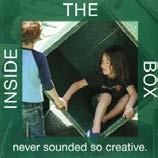


We’re happy to announce that C&C’s 2016–2017 Annual Appeal has won a Bronze Award as part of the Council for Advancement and Support of Education (CASE) District II Accolades!
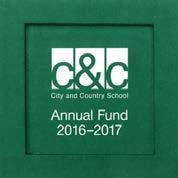

C&C has recently added a new sport to its lineup: Ultimate Frisbee. Ultimate is coached by two pro players from the NY Empire team—NY’s only pro team. It turns out C&C has pretty talented ultimate players, as they haven’t lost a game yet in our frst two seasons. C&C Sports moved from softball to ultimate because the felds used by C&C are more conducive to this type of sport, the equipment is a snap, there’s more movement in the game, and it’s overall a more accessible game. Plus, it’s simply impossible for students not to enjoy themselves playing this game.

We apologize that the following two donors were accidentally left out of our 2016–2017 Annual Report: Sponsor ($1,000+)
W. Corby May Donor (Up to $499) Ellen Sarna
Philip Langner ’39: At 91 years old, I may well be the oldest living graduate. City and Country was an absolutely marvelous experience for me, and it afected my life enormously! Since leaving C&C, in my career I have produced 16 plays on Broadway, starting in 1952, including Absurd Person Singular, Golda, and State Fair I also co-produced fve flms, including Judgment at Nuremberg, which I found, persuaded Spencer Tracy to perform in, and which won two Oscars (Best Actor and Best Adapted Screenplay). The other movies I produced were Slaves, Born to Win, A Child Is Waiting, and The Pawnbroker. In addition to Broadway and movies, for over 30 years I organized theatre cruises leading groups of Broadway stars and passengers on 34 adventures around the world! City and Country is the greatest—it started it all!


Hilary Knight ’40: I have had a big year. I’m a fullyfunctioning 91-year-old artist who belatedly realizes how much of my interest in creating and continuing to absorb new things and ideas comes directly from C&C, Caroline Pratt, and her great wooden blocks. I am currently working on a book about my career, Drawn from Life—mostly illustrations—and C&C is very much present in it. Last year I had the great honor of having two exhibits of my

work: Eloise at the Museum at The New-York Historical Society and Hilary Knight’s Stage Struck World at the Lincoln Center Library. Of late, I’ve been passing by the School frequently, as I have been commissioned by designer Anna Sui to do a mural for her nearby apartment. (I started my career in the ’40s painting murals, and still do create them—including one for Tommy Hilfger, for whom I created a mural in his Plaza Hotel apartment.) I also have two books for St. Martin’s Press keeping me busy. Besides my autobiography, the other is an adult graphic memoir (Olive & Oliver: The Odde-Balzz’s). When my family came to live in Manhattan in 1932, there was no question where
I would be going to school—just down the street, crossing Sixth Avenue (under the El) to City and Country. Now in 2018, my memories are vivid. Several visits over the years have astonished me. A few things have changed: no more 12th Street entrance, the El is gone. The school has remained the same. What a rarity in this incredible new world. It still echoes with the ideas and teachings of
its founder, very much present when I was there. Visiting a classroom of children today, still building bridges with her blocks! The very same printing press still at work. My guilty favorite was Rhythms, way back in 1932. We were all Flash Gordon with China silk capes. I feel a very strong tie that connects me after all of these years to City and Country School.
Leigh Berrien Smith ’41: Leigh wrote us to say that she “turned 90 in August and celebrated vigorously with family.”
Johnny Sonneborn ’44: I am an accompanist and organist, choirmaster, and music director in Christian and Jewish congregations. My work on peace initiatives with the Unifcation Church began in 1971 and has continued through today. Additionally, I began writing and publishing academic texts in 1982, and I am pleased to report that this is an ongoing activity. Recently, I completed a secular presentation on the topic, “Children’s Staged Maturation and Ideal Parental Attitudes and Activities in Each Stage.” The presentation revolved around my life and teachings, including my childhood immersion in progressive education and determination to contribute to a world without war in high school. In my life, religion has held deep meaning, and I continue to search for ways where people help one another rather than harm. My participation in faith-based pacifst organizations has guided my knowledge and appreciation for the world, including tutoring in a charter school and observing best practices for additional study in courses, online texts, and interviews.
Ilse Jenkins Gay ’46: After graduating from City and Country, I went up the street to Washington Irving HS, where I spent three years mixing it up with a few thousand girls from all over Manhattan. Instead of completing my senior year, however, I dropped out and went to Europe. When I got back to New York, my mother had given up our apartment on Charles Street and moved to Santa Fe, NM, where I dutifully, if reluctantly, followed. That fall I started at the University of New Mexico in Albuquerque, but after two years, I once again dropped out—this time it was for love! We married, settled in Albuquerque, raised three boys and, I am grateful to say, our relationship and our bodies have survived for 67 years. I returned to UNM and completed the unfnished bachelor’s degree and two graduate degree programs, and started a 22-year career at UNM, including as Assistant Dean in the College of Fine Arts and creator and Director of the Employee Assistance Program for Faculty and Staf. One activity which consumed a great deal of my energy a few years ago was the discovery of a box of letters written from my grandmother to my father while she was in prison in the late ’20s. This gift of letters opened up a host of doors, which allowed me to learn about my ancestry and roots in Canada, Boston, and New York. I now understand how the disease of alcoholism threads its way across borders, time, achievements, education, social standing, wealth, and poverty—and our intentions. I published her
biography, titled Love & Skisskes fr Mother, her sign-of in each of the 20 letters she wrote her son over a three-year period of incarceration. I consider this experience one of my life’s greatest. The other great gifts in my life include getting a scholarship to C&C when I was nine. My view of it all is that I stayed on the fring line of life—not an easy nor necessarily comfortable position, but one which has brought me a deep sense of gratitude and humility for all that has happened to me in my life—and all that hasn’t!
Peter Goldman ’46: On the eve of my 85th birthday, I’m still plying the trade I began as a newspaperman in St. Louis and pursued for 46 years at Newsweek: I’m writing. It’s crime fction now, not nonfction. I’m currently doing a fnal edit on my fourth detective novel and my 14th book overall. And I continue thinking about how the man I am today was shaped by C&C more than by any other school at any level.
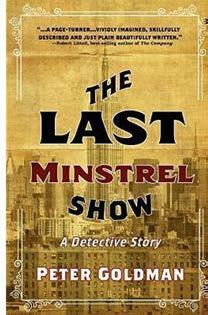

Judy Slater Geller ’47: After graduating from C&C, I attended Dalton (with only 44 girls), and earned a bachelor’s degree in biology at the University of Michigan. Following, I attended a year of medical school at NYU and then realized it was not what I wanted. Rather, I followed my 12-year goal of going into the sciences, particularly in research. I followed my path and spent six summers doing research, later earning a master’s degree from NYU. Ultimately, I decided that I wanted to teach, so I joined a small tech school for one year and then took a part-time job teaching ninth grade biology at Dalton. Sixty years later, I still enjoy teaching grades 7-12. When I think of how I developed my philosophy of education, and my openness to new approaches, I think most often of what I learned from C&C. It was, and from a recent visit, still is an amazing place for children to learn. I raised two girls and I now have a fve-year-old grandchild. I enjoy spending time with friends, seeing Of-Broadway theater, reading, tennis, and watching students play basketball.
Anneli Muschenheim Arms
’49: I continue to do my prints at Manhattan Graphics Center (MGC) and also have shown them there (as well as elsewhere). My work is now smaller, and since my hip operation, I do fnd it difcult to get around. My husband, John, died last August after almost 61 years of marriage, but my son and his wife have been very helpful. Last spring I gave a talk at MGC on my “55 years in SoHo” (before it was SoHo), and I am still in my large loft. I recently donated a print titled “Burrowing Owl” for the C&C Annual Spring Beneft auction. I was in a Sound and Image

exhibit at Westbeth Gallery in February with my “Music Muse” sculpture and my “Bel Canto” and “Architect of His Dreams” prints via the Federation of Modern Painters and Sculptors, of which I have been President for about 30 years, though I am now more or less retired. Please look at my website (anneliarms.com) to get an idea of what I have been doing for more than 55 years. I am still in occasional contact with John Sarna and Steve Meyers, and have been in continuous yearly contact with Chin Chi—after she came back from China in 1980 (I visited her there in 1979).
Eric Auerbach ’49: My wife, Barbara, and I recently traveled from Patagonia (Argentina) to the Atacama desert (Chile). We had never been of the North American continent prior to this.
Daniel Goode ’49: Following C&C, I attended Music and Art HS before going to Oberlin and Cornell, where I studied philosophy. I received a master’s degree at Columbia in Music Composition, and founded the DownTown Ensemble (for new music) in 1984. In 2004, I founded the Flexible Orchestra: a new idea for orchestral music (fexibleorchestra.com). I attribute all that I have accomplished to C&C as an education and an inspiration. My mother, Ruth Goode, ghost-wrote I Learn from Children with Caroline Pratt, C&C founder and Principal, based on her autobiographical account of her school and herself. (You can fnd out more about me at danielgoode.com.)
John Sarna ’49: Life after C&C? I received my bachelor’s and master’s degrees in Civil Engineering from Cornell University, and I have been involved in transportation planning throughout the Hudson Valley region for almost my entire professional career, with a few assignments in Canada, Argentina, and the American west. After retiring from the corporate world, I started my own consulting practice, which is only now winding to a close. My hobby has been singing—with the Walkabout Clearwater Chorus (Pete Seeger’s chorus), the Westchester Gilbert & Sullivan Group, and several folk music groups. I went to Europe twice, with two diferent choruses. Many years ago my folk group entertained at the C&C Fair. I still play the recorder; it can be heard on the Walkabout CD. I also play the guitar, Celtic harp, and the pennywhistle. My wife, Estelle, and I have been married 57 years. We have two daughters and four grandchildren. We have been living in the same house in Rockland County, NY, since 1970. We have traveled to over 40 countries, and still have trips planned. Almost 70 years in 200 words. Wow!
1950s
Carol Levine Paasche ’51: My father was the school doctor, Milton I. Levine, MD. My sister, Annie Levine Parker ’55, also attended C&C, graduating four years after me. She is married to a C&C alumnus,
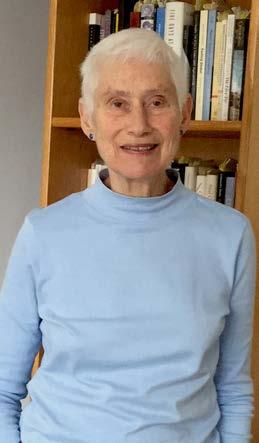
Ted Parker ’55. From C&C I went to Elisabeth Irwin High School, and then to Antioch College, graduating in 1959 with a degree in Psychology. I received my master’s from Harvard in Counseling and Guidance. In 1960, I married J. Gottfried Paasche, whom I had met at Antioch. From there we went to the University of Michigan in Ann Arbor. I continued my studies in Educational Psychology, while my husband worked towards a PhD in Sociology. We had our frst child, Franz, in 1962. Our second child, Denise, was born 18 months later. Our fnal child, Sara, was born in 1967. By that time, we had moved to Toronto, where my husband was a Professor at York University. When Sara was two years old, I began working at Seneca College, as a Professor of Early Childhood Education. I taught and coordinated studies for 30 years, and then took early retirement in order to set up a parent and child counseling practice. I have also authored two books. After almost 50 years in Toronto, we moved back to the East Coast to be closer to our three children. We also bought land in St. Johnsville, NY, and enjoy gardening and the outdoors. We share as a family a love of the outdoors, eating homegrown produce, and caring for the land. We moved to Newton, MA, two years ago and are settled comfortably in a twofamily home (our youngest daughter and her family have their own entrance, and live upstairs). Our older daughter is married to a graduate of C&C—Tony Blofson ’71. I am still in touch with three people from my C&C class—Judith Goode, Penny Tyson, and Mary Diddy Spoerer
Felice Aull Nachbar
’52: I was only at C&C for two years, but they were transformative. My daughter, Nancy Nachbar ’81, attended all the years. Here are my recent activities: In 2008, I retired from the faculty at NYU School of Medicine, but I have an adjunct appointment in its Division of Medical Humanities. Although I started out at NYU as a physiologist, I eventually became interested in medical humanities and developed a website of annotations in literature, art, and flm (The Literature, Arts, and Medicine Database at NYU). Also, I designed an elective course in the feld, which I taught for eight years before my retirement. I review poetry for the Bellevue Literary Review and am on its advisory board. I managed to get a poetry collection published in July 2017: Mandatory Evacuation Zone (see my website: feliceaull.com). I’m still grappling with my husband Marty Nachbar’s sudden death in 2015 – he was known to the C&C community for helping to bring computer education into the School. I’m grateful to be living in New York City with its many helpful distractions, some of which are free – even just ambling around local neighborhoods.
Ellen Rosenberg Tovatt Leary ’55: Here we are sitting around a table at Musso & Frank in Los Angeles. From left: my husband, David Leary, me, Annie Levine Parker (alum), Ted Parker (also an alum), Leslie Easterbrook, and her husband, Daniel Wilcox (yet another alum!): Our graduating class of ’55!
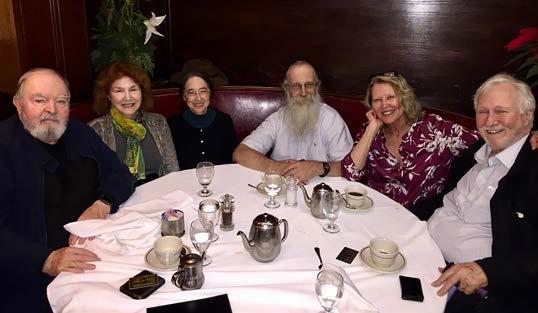
I worked for The Metropolitan Museum of Art as a writer in the Public Relations department, and then formed my own company, Pivot Design Services, representing architects’ original product designs for manufacture. I recently wrote and gave a speech about my grandfather, David Dubinsky, at a dinner given in his posthumous honor by the Soroka Medical Center of Israel. He was president of The International Ladies’ Garment Workers’ Union (ILGWU) for 32 groundbreaking years, a world fgure, a statesman, and “a great man with the common touch,” as a family friend recently said. My daughter, Emma, is a dedicated preschool teacher, getting her Master of Special Education, and is engaged to be married. I have been working to explore, preserve, and perpetuate our family legacy and history. City and Country remains a unique, formative, and rich experience I will always remember.
Ryna Appleton Segal ’59: C&C was a “home,” as well as a school. The Store and Post Ofce were great experiences, as was Shop, and Art with Al (Albrecht Freudenberg, Art Teacher from 1945–1960). I will always remember the Library, and I cannot forget blocks and Rhythms, where I later discovered we were moving to Beethoven and the music of other wonderful composers. I am a singer, and I am sure my love of music was nourished at C&C. I also know that we had exceptional and dedicated teachers who enriched our learning and gave so much of themselves. I believe that City and Country gave me a unique foundation, and the tools to think associatively across issues, which enables me sometimes to see connections and solutions others may not. There is only one C&C, and I am glad whenever I walk by to see it thriving. After graduating from Byrn Mawr College with a degree in art history, I received a Master of Art and Education in the 1980s and was a practicing artist and teacher specializing in monotype printmaking.
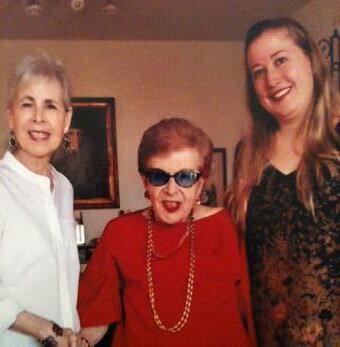

Stephanie Hirsch Meyer ’60: I have had a wonderful life. My two children, Alison and Rob, are well and happy and have given me four amazing grandchildren, who have been the joy and focus of my life. Three grandsons and now a granddaughter, they have brought such joy to my life and brought all my wonderful years at C&C fooding back, as I have given them blocks and books to enrich their imaginations as mine was during those years. My husband and I, as its editor, founded and published a teenwritten magazine, Teen Ink, for 28 years, which reached high schools nationwide. We were able to showcase over 50,000 examples of teen expression, both written and visual. After the death of John a year ago, I sold Teen Ink, and I am grateful that it continues each month. We lived in Newton, MA, for 35 years, but over the last 10 years, we reacquainted ourselves with New York, and now I live in Brooklyn (part-time) to be closer to my son and his family. A lifelong reader, thanks to Bluie (Mary Bird Piel, Librarian from 1946–1970), I savor the outdoors and often take my cavalier for walks. I still so value and enjoy children that I volunteered at a Boston magnet school to read (I also read at our local library). My cavalier has brought many smiles to nursing home residents and at the local hospital where we have visited the psych unit weekly as a pet therapy team for the last fve years. A very good life, I am grateful for my health and family, as I continue without John, my partner of 47 years.
Lisle Kulbach ’62: It’s very nice to fnd an active interest emanating from City and Country as to what has become of the graduates. I live in the Boston area. I feel a little embarrassed by the ensuing list, but here goes: I’ve been a musician for many years, mostly in the feld of Early and Sephardic Music. I’m one of the founding members of “Voice of the Turtle,” a quartet that specializes in Sephardic music. We have a number of CDs that can be found through Amazon. Currently, I’m also performing in a trio
called Promised Land. The program deals with immigration to the United States through skits and musical numbers. As well, I’ve made a little flm about my grandmother’s art, 12 minutes, that can be found on YouTube under “Elsa Frankl, Art Works.”
Maud Haimson Nerman ’63: 1960 in the XIs was my best school year. I am an Osteopathic Physician specializing in the treatment of traumatic brain injury. My groundbreaking book, Healing Pain and Injury, has generated praise from professionals and patients alike.

Eric Darton ’64: This past year I launched, in collaboration with two co-editors, an online journal of world literature called The Wall (wittypartition.org). The Wall features a good deal of work in translation, with the English version next to the original language, if possible. In addition to writing in all genres, each issue contains a portfolio of contemporary visual art. Now on our third issue, The Wall has attracted an international audience of approximately 2,000 readers. I am also continuing to post, bi-weekly, an extended work of independent scholarship, Book of the World Courant (bookoftheworldcourant.net). Courant explores the relationship between forms of cultural expression (including visual art, written, and spoken language) and systems of political and economic power. It also navigates the seam between Eastern and Western thought, using humor, and an occasional striking visual, for leavening.
Steve Cartwright ’65: I plan to complete a biography this year on longtime friend Dahlov Ipcar ’31 (pictured), artist, novelist, and children’s book author, among other things. She died in 2017 at age 99, possibly the oldest living C&C graduate at the time. Born in Vermont, Dahlov grew up in Greenwich Village with artist parents Marguerite and William Zorach (C&C’s frst Art Teacher). She spent

most of her life at Robinhood Farm in Maine. My mother, C&C alumna Sally Cartwright ’37, died in 2016. She and her late husband, Roger Cartwright, both taught at C&C. I enjoy running and boating, time with my daughter and grandson, and visiting nearby brother, Paul Cartwright ’67. You can reach me at writer@midcoast.com.
Jonathan Rose ’66: I’ve just published Readers’ Liberation (Oxford University Press), which in a fundamental way is inspired by what I learned at City and Country 50 years earlier. The book is a history of independent readers—that is, readers who chose their own books, exercised their own critical judgment, questioned authors, and didn’t rely on the opinions of critics or professors. That is something C&C always encouraged, simply by mandating an hour of quiet reading in the Library every day. We could read whatever we liked, but we had to read. That taught us the most important lesson that any school can teach—that reading is an endlessly fascinating and emancipating experience. In glaring contrast, public schools today have been hijacked by Common Core, which ofers prepackaged snippets of literature accompanied by simple-minded questions. I deconstruct a Common Core anthology, which looks like something deliberately designed to make students hate reading, and usually succeeds in accomplishing that. I recommend scrapping all the high-priced textbooks and reading specialists, spending the money saved on library books, and then telling each student to pick one and read it. That certainly worked at C&C.

Peter Alson ’69: I’m living in a brownstone on 11th Street in the Village, around the corner from the house I grew up in, and from which I walked to C&C every day a long time ago. My 90-year-old mother, Barbara, lives on the bottom two foors, and my wife, Alice, and our daughter, Eden, and I live on the top two foors. Alice and I are both writers, she in television and movies, me in books. Elevenyear-old Eden goes to 75 Morton, the new public middle school of which I am an involved participant as a member of the School Leadership Team. Like most of the people we know, we are actively resisting Trumpism and the evil plutocracy behind him that is threatening the foundations of our democracy.
Hilary Sessions Siemer ’69: I currently live in Los Gatos, California. I am a second grade teacher at Most Holy Trinity School in San Jose. During my free time, I enjoy bike riding, hiking, and singing with the San Jose Symphonic Choir. I have two beautiful children, one in LA and the other in New York.

Eric Wassermann ’70: I am a neurologist and a Principal Investigator at the National Institute of Neurological Disorders and Stroke in Bethesda, MD, where I study how the human brain learns and adapts and how (just maybe) to make those processes more efcient in patients and healthy people. I have taken multi-year excursions into helping to develop widely used techniques for stimulating the brain with magnetic pulses, and working on medical counterterrorism problems for the George W. Bush administration. My college sweetheart and I have a 26-year-old daughter in Galway, Ireland, and a 40foot sailboat on the Chesapeake, both of which bring us great joy and provide efcient outlets for time and cash. Retirement is no longer an abstract concept, but I will keep plugging away for a few years. My email address is very easy to fnd using the info above, and I encourage anyone who wants to get in touch to use it.
Peter Mandel ’71: I am a journalist and an author of books for kids, including Jackhammer Sam (Macmillan). Recent articles include, “A Sojourner Cheats the Chill in the Warmth of Argentina and Uruguay,” which ran in The Washington Post, and “The Best Way to Oversee Our Elections,” which appeared in Newsday. I live in Providence with my wife, Kathy, and rescue cats, Cecil and Emily.
Jill Weitzman Fenichell ’72: I have been involved in the antiques and design business since 1983. I work as an antiques dealer and appraiser, specializing in advising clients on everything from selling entire estates to acquiring that one special object. As a ceramics and glass specialist, I have sold objects to The Metropolitan Museum of Art, The Corning Museum of Glass, Colonial Williamsburg, The Museum of Fine Arts, Boston, Bayou Bend, and many other art museums and cultural organizations both in the U.S. and abroad. Additionally, as a designer, my work has been featured in books, magazines, and many interiors around the world. If there is one thing I would love in my workshop above all others, it would be the bicycle jigsaw Shop Teacher Haim (Haim Mendelson, Shop Teacher from 1964–1991) had in the Shop. I’m thinking of trying to make one here in Brooklyn.
Geofrey Mandel ’73: I graduated from UNIS in 1977. After attending Tufts and Stanford, and kicking around the publishing world in New York and Boston, I took a career detour to NYU’s graduate flm program, where I wrote and directed the Student Academy Award-nominated short “Kill the Director.” My frst industry job was as an art department assistant on Star Trek: Deep Space Nine, and since 1995 I have been working as a graphic designer for flms and TV shows, including Space: Above & Beyond, JAG, NCIS, Star Trek: Voyager, Spider-Man 2, Serenity, Blades of Glory, Dirt, X-Men: First Class, Gangster Squad,
Parks & Recreation, Mad Men, Agents of S.H.I.E.L.D., The Muppets, Black Mass, La La Land, Hairspray Live!, LEGION, and Downsizing. (In other words, those C&C art skills really came in handy.) In my spare time, I design and illustrate props, blueprints and star maps for various science fction franchises, including the Serenity blueprints, and maps of the Star Trek, Firefy, and Battlestar Galactica universes. I live in beautiful downtown Burbank, and I blame C&C for sparking my interest in art, design, and typography. Visit my website, geofreymandel.com, to get in touch.
Sam Schoemann ’79: After 20-plus years in the entertainment and advertising industries, I’ve jumped on the California “Green Rush” and joined C4 Distro—a legal cannabis distribution start-up based in Los Angeles. Of note, C4 investors include Bill Lockyer, former attorney general of the state of California, and Eric Spitz, exchairman of the board of the Orange County Register. I’m a Brand Solutions Expert and I manage the relationships between the products we represent in the marketplace and our retail partners. It’s fun to be involved in a burgeoning industry.


Maximilian “Max” Sternberg ’07: My brother, Alexander “Ali” Sternberg ’02, went to George Washington University, and then received a Master of International Education at NYU. He worked at NYU for three years, and recently left for a new job. I went to Northwestern, and I am now half-way through my law degree at Columbia University, where, lo and behold, I have connected with Dorothy “Dot” Weldon ’07, who is in the same year at Columbia, also studying law.
Jamie Dalgleish ’09: I went to high school at Dwight-Englewood School (Class of 2013) and graduated this past May in the Class of 2017 from Mount Allison University in New Brunswick, Canada, having earned a BA with a major in Environmental Studies and a minor in Environmental Science. I work for Sea Education Association (SEA) as a steward in training aboard their two sailing school vessels—the SSV Robert C. Seamans sails the South Pacifc and the SSV Corwith Cramer sails the Atlantic Ocean. SEA runs environmental studies and oceanography
semester and summer programs for undergraduate students, as well as a summer program on their campus, on Cape Cod, for high school students. As a steward in training, I work with stewards cooking the daily meals and maintaining a tidy ship while underway and during shipyard periods.
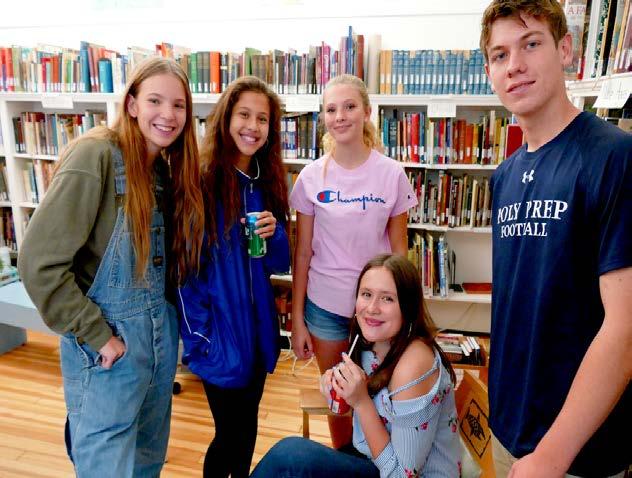
Lauren Caraballo ’14: From a very early age, I have been passionate about art. While at City and Country, I was encouraged to explore my passion and push myself. After leaving C&C in 2014, I attended a boarding school in New Hope, PA, called Solebury, where I’ve grown as an artist. I was lucky to fnd a progressive boarding school with an amazing art program. It felt a lot like C&C, but this time, I was in the country. At boarding school, I worked with admissions, giving tours to prospective families and guests. I am also one of four students chosen to be a part of their Academic Committee for the last three years, and I’ve been a part of their theater productions since freshman year. During my summers, I mostly attended pre-college programs at local colleges (Cooper Union and SVA), but the one summer that meant the most was when I volunteered for a community service trip to Japan. Those fve weeks serving the community were life-changing. Recently, I was lucky enough to get accepted to my dream school through the early decision process. I will be attending Rochester Institute of Technology this fall as a 3D Computer Animation major.

Heloise Becker “Becky” Colby ’41: Becky passed away in October. She taught elementary school in California, Colorado, and Oregon. Becky was known to many as “The Blueberry Lady.” She nurtured the organic berries she sold at her U-Pick operation and to restaurants and natural groceries in the area on the Blueberry Hill property where she had lived for 40 years. Becky loved the arts, NBA basketball, and shooting pool. A true Renaissance woman, she played many musical instruments, studied modern dance, was involved in theater, drew, painted, made jewelry, and did just about anything else that struck her fancy. City and Country extends our deepest sympathy to Becky’s family.
Anne Hale Codding Tonachel ’44: Anne passed away suddenly in January. Though she only spent a few years at City and Country (1942-1944), it made a lasting impression. As a co-founder of the West Village Nursery School, she championed the progressive education practices that she experienced at C&C. And, she remained connected to many of her classmates up until her death, including her companion of the last 20 years, Pierre Epstein ’44. She was a social studies teacher for 25 years at what is today LaGuardia HIgh School, and she also taught at Browning for a number of years. Anne was a longtime, and active, resident of the West Village, involved in many community improvement projects, historic preservation, and campaigns to keep major highways out of the city. City and Country extends our deepest sympathy to Anne’s family.
Olivier Sahli, who attended C&C for one year, most likely in 1988–1989 as a IX (though even he can’t remember!) has reached out to us seeking his former classmates. He sent along this photograph of the School Store—a fondly remembered space with fondly remembered people.

Do you recognize yourself in the photo?
Please notify us at alumni@cityandcountry.org.
April 21, 2017
Nearly 80 alumni from the Classes of 1944 to 2016 came back to visit with classmates at the 2017 Alumni Reunion. Many came early for an Archives Presentation from Jordis Rosberg, our Archivist. Retiring Principal Kate Turley was made an honorary alumna during the evening.

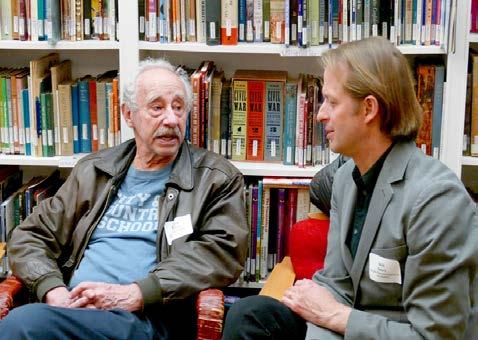



October 14, 2017
Over 35 high-school-aged alumni came back to C&C on the day of the Harvest Festival to see their old friends and former teachers.



February 21, 2018
High school seniors Isa Skibeli, Lucas Larson, Sasha Amari, Hal Munger, Lucie Bisbee, and Emma Bates (pictured, left to right) came back to speak to current parents and students about their high school experiences. The entire Class of 2014 was invited, to make it a mini-reunion. Our brandnew sound system was used, paid for in part by Annual Fund donations from the Class of 2017 parents.
December 11, 2017
Alumni were invited to learn about the work that C&C is doing with social justice integration at an evening panel. (See page 15 for a description of this event.)




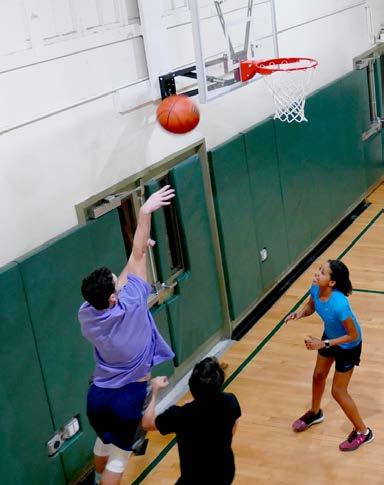
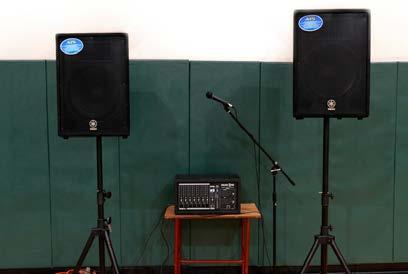
March 15, 2018
Alumni from the Classes of 2013–2017 were invited in for a special game to face their former coaches. The verdict? The alumni were victorious!
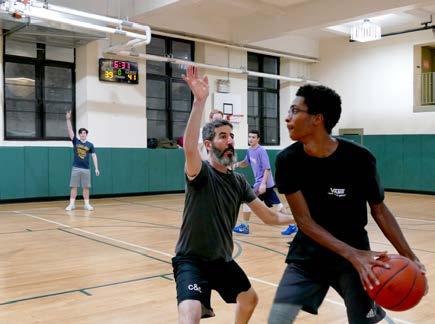
Participation in our fundraising endeavors is a show of belief in the School, its mission, and programs. City and Country is grateful for your support, which continues to strengthen our community and ensure its future.

The Annual Fund helps keep City and Country vibrant and preserves and improves the progressive practices and programs that make us unique. The Annual Fund directly supports the fulfllment of our mission, through curriculum enhancement, new and established programs, classroom supplies and renovations, fnancial aid, and professional development. Every gift is important, no matter the size, and indicates your support of our mission. The 2016–2017 Annual Fund raised over $820,000.
To make your gift to the 2017-2018 Annual Fund, mail a check to the Development Ofce in the attached envelope or donate online (visit the Support section of the C&C website). The deadline is June 30.
The Spring Beneft is a parent-organized fundraising event held each year. Members of the community support the event by purchasing tickets, bidding on auction items, or making a donation in the paddle raise. Funds raised support current and future fnancial aid. The 2018 Beneft raised over $420,000.
City and Country established an Endowment in 2014, the School’s Centennial year. A robust Endowment will help ensure the strength of City and Country for generations to come. The Endowment stands at nearly $7,000,000.
Increasingly, our community uses planned gifts to augment outright giving to the School. Planned or deferred gifts, such as bequests, gift annuities, and charitable remainder trusts, provide income to City and Country for many years into the future, and allow individuals to leave a legacy of learning. Our Legacy Guild recognizes donors who have honored the School with a planned gift.
For more information about making a donation to any of these initiatives, as well as additional information (such as making a gift of stock), contact Penny Arnold, Director of Development, at pennya@cityandcountry.org or 212.506.5945.
146 West 13th Street New York, NY 10011
212.242.7802
www.cityandcountry.org
Do you remember what year this Spring Fair took place? Do you remember being there, and want to share a story of what it was like?

Email us at communications@cityandcountry.org.
Update Your Contact Information
If you’ve received this publication from us, but haven’t received an email from us recently, please send your email address to alumni@cityandcountry.org.
Young Alumni: If you’ve moved to a new address after college, please update us at alumni@cityandcountry.org.